

Dodge Journey P0420: Meaning, Causes, + How to Fix

This page is meant to help you troubleshoot the Dodge Journey P0420 trouble code. It covers the P0420 code’s meaning, symptoms, causes, and possible solutions.
P0420 is the most common OBDII code and is virtually never a breakdown risk.
A failing oxygen sensor or bad catalytic converter are the most common causes of P0420.
Table of Contents
- Quick Info Table
Dodge Journey P0420 Quick Info Table
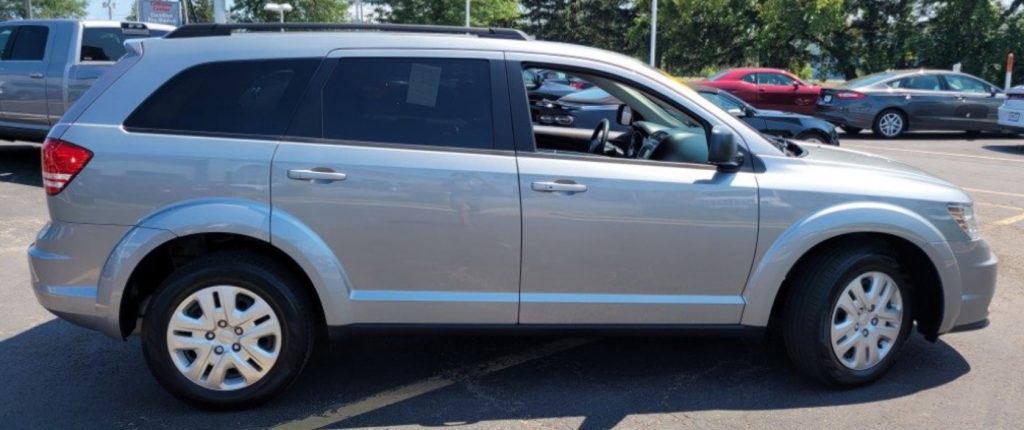
Dodge Journey P0420 OBDII Code Defined
P0420 is generic (has the same meaning for all vehicles made in 1996+) OBDII trouble code. Here’s the technical definition for your vehicle:
P0420: Catalyst System Efficiency Below Threshold (Bank 1)
Catalyst System Efficiency
Your Journey’s exhaust contains hydrocarbons, carbon monoxide, and other harmful gasses. Catalyst system efficiency is the percentage of these chemicals removed from the exhaust system. Oxygen sensors measure these pollutants.
Efficiency Below Threshold
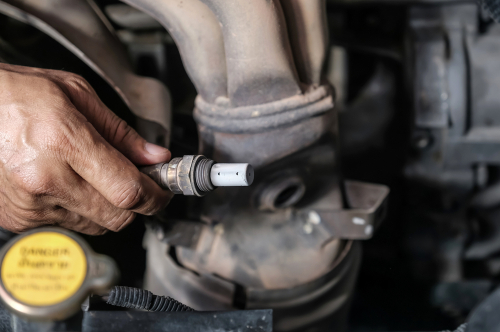
When the readings from the upstream and downstream oxygen sensors show similar readings (not enough pollutants expelled from the exhaust), your vehicle will throw the service engine soon light (P0420).
These readings shouldn’t match since the catalytic converter is supposed to scrub the pollutants from the exhaust.
When the readings from each O2 sensor get close, the software in your Journey’s PCM believes that the catalytic converter is no longer doing its job. This can happen for three reasons:
- The exhaust is escaping before it is measured
- The catalytic converter is losing efficiency and needs to be replaced
- The O2 sensors are not reporting the right readings from the exhaust
You can ignore this section if your Journey has an inline engine or if the exhaust manifolds merge into one pipe before the catalytic converter.
Most vehicles only have one catalytic converter But, if your vehicle has dual exhaust, you’ll need to determine which side of the engine is the bank one side.
Bank one is the side of your Journey’s engine with the first cylinder. Typically, the first cylinder is closer to the front of the engine. A quick Google search for your vehicle’s engine and model year can quickly confirm that. The bank 2 version of this code is P0430 .
Dodge Journey P0420 Code Symptoms
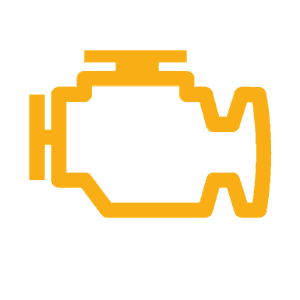
The P0420 code in a Dodge Journey will often be thrown if one of your vehicle’s oxygen sensors is not functioning correctly.
There are rarely drivability issues associated with P0420. For most people, the first sign that anything is wrong is the service engine soon light coming on.
Here are the typical symptoms that something is wrong when you have code P0420:
- Service Engine Light – Often, this is the only symptom.
- Rotten Smell – A rotten egg or sulfur smell is a telltale sign of a bad catalytic converter.
Related: P0442 Dodge Journey
P0420 Causes

Here are the most common causes of P0420 in the Dodge Journey:
Likely Causes
- Bad catalytic converter
- Bad O2 sensor
Other Causes
- Exhaust leak
- O2 sensor wiring
- Overheating converter (usually caused by a misfiring engine, there should be codes)
- Burning oil (overheats converter, usually no code)
- Engine not heating up enough
P0420 Diagnosis: Dodge Journey
The most common fix for P0420 in the Dodge Journey is a new catalytic converter, followed by an O2 sensor replacement. Before taking your Journey into an exhaust shop for an (expensive) new catalytic converter, let’s ensure that’s what you need.
Here’s a good P0420 diagnostic order for the Dodge Journey:
1. Check for Other Codes
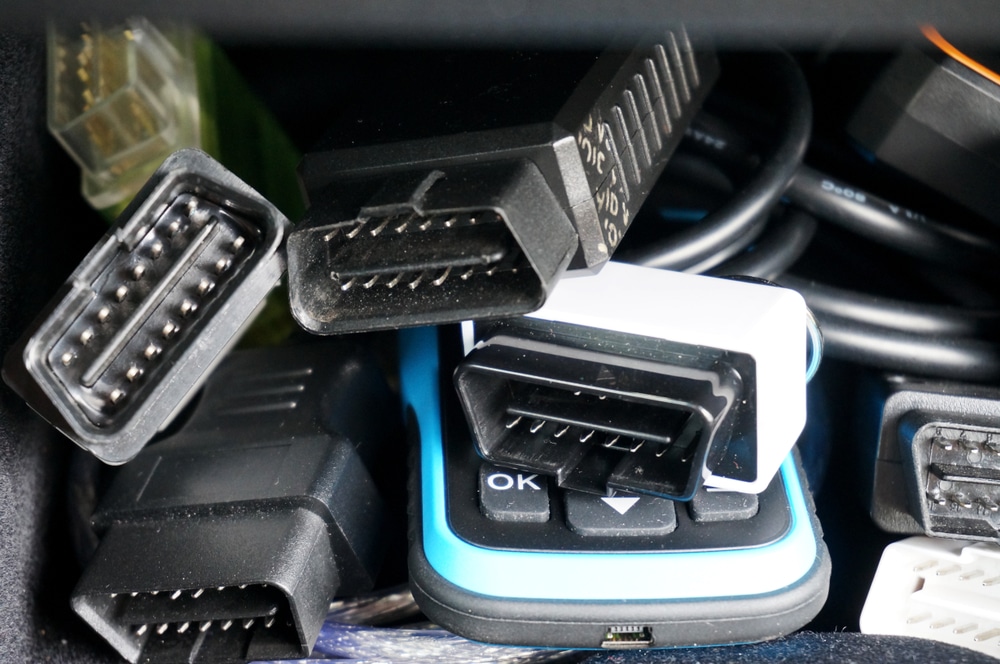
The first thing you want to do when trying to fix P0420 in the Journey is to verify there aren’t any other trouble codes. Three types of codes can give clues as to what’s going on with your vehicle.
Misfire Codes
If you have a misfire-related code (such as P030X, where X is the misfiring cylinder) or P0300 (random multiple misfiring), it can cause the catalytic converter to overheat, which decreases its efficiency and throws P0420.
Engine Temp Sensor Codes
If your Journey’s computer doesn’t know the engine temperature, it’ll keep the fuel mixture rich. When this happens, the exhaust the O2 sensors see will be out of range, and it could throw P0420. You should see P0128 along with this code.
O2 Sensor Codes
If your vehicle has any O2 sensor-related codes, jump to section three.
2. Exhaust Leak (Easy to Check)
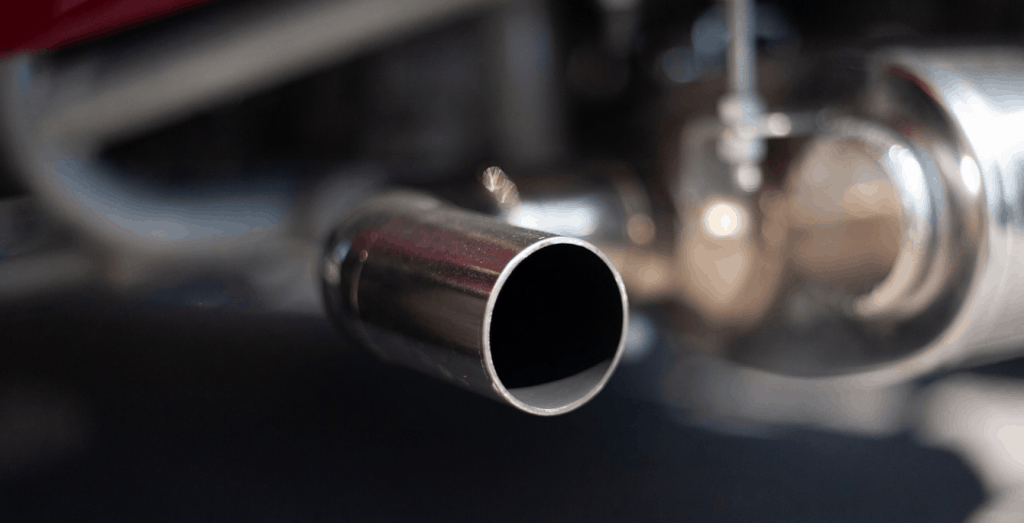
It would be a good idea to check your vehicle for an exhaust leak first. You should be able to hear it easily when looking underneath your Journey.
An exhaust leak can cause P0420 since it causes exhaust gasses to escape unmetered.
If your vehicle doesn’t have an exhaust leak, you’ll need to test the O2 sensors and/or catalytic converter.
3. Test the Oxygen Sensors
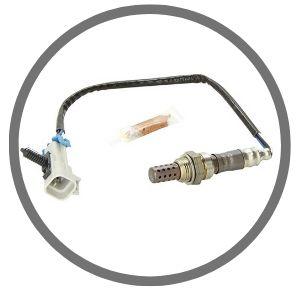
Your Dodge Journey has at least two oxygen sensors, one before and one after the catalytic converter (commonly referred to as the upstream and downstream O2 sensors).
- Upstream – The upstream (before the exhaust gas hits the catalytic converter) oxygen sensor measures the exhaust gasses as they exit the engine. The Powertrain Control Module (PCM) uses this data to adjust the air-fuel ratio, ignition timing, and more.
- Downstream – The downstream oxygen sensor’s (after the exhaust exits the catalytic converter) primary function is to verify the catalytic converter is doing its job .
Often, an oxygen sensor is the cause of P0420. When an oxygen sensor has failed, it can cause a false reading and trigger this code in your vehicle. You can test the sensor before replacing it. The videos below show you how to test one with a multimeter or professional scan tool.
How to Test an Oxygen or O2 Sensor (YouTube: Multimeter and Torch) How to Check the O2 Sensors (YouTube: Scan Tool)
4. Inspect the O2 Sensor Wiring
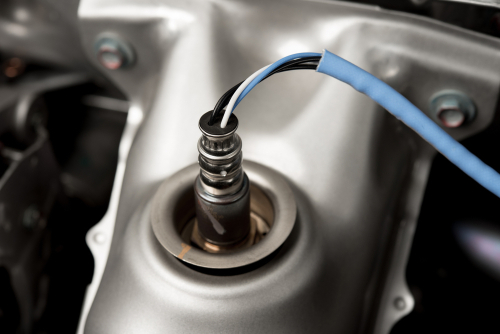
Over time, the oxygen sensor wiring can go bad. It is especially volatile since it is right next to the hot exhaust at all times. The downstream oxygen sensor wiring is also fragile since it is far from the ECM, and the catalytic converter can get hot (more distance to travel = more area to fail).
How to Test Wiring in Under an Hour (2 Car Pros)
5. Catalytic Converter (Most Common)
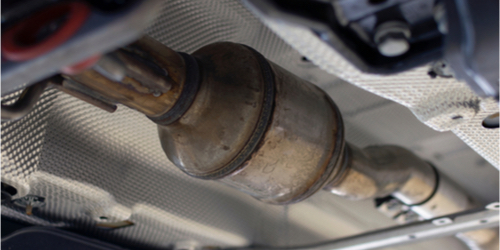
The catalytic converter is responsible for scrubbing out as much pollution as possible from your Journey’s exhaust.
Over time, it can lose its ability to strain pollutants out of the exhaust. Although modern catalytic converters are supposed to last the life of most vehicles, over time, they can lose their ability to strain pollutants out of the exhaust.
There could be some underlying problem if it has clogged, such as a misfire, an air/fuel mixture that is too rich, or oil getting into the cylinders. You can test your catalytic converter with a heat gun to see if it’s overheating (see how in the video linked below).
How to Test Your Catalytic Converter in 15 minutes (YouTube)
If there are no codes other than P0420 present, and the O2 sensors are recording data properly, it’s likely your Dodge Journey’s catalytic converter has failed, which is what this code is reporting.
Share this:
P0420 Dodge Bank 1 Location: Exact Location and How to Fix It
The P0420 code for a Dodge vehicle indicates a problem with the catalytic converter on bank 1. P0420 is a diagnostic trouble code that relates to the catalytic converter on bank 1 in Dodge vehicles.
When this code appears, it suggests that there is a malfunction with the catalytic converter, specifically on bank 1. The catalytic converter is responsible for reducing harmful emissions from the vehicle’s exhaust system. If the catalytic converter is not functioning properly, it can lead to decreased fuel efficiency and increased emissions.
We will discuss the potential causes of the P0420 code in Dodge vehicles, its symptoms, and possible solutions to rectify the issue.
Symptoms And Causes
The P0420 Dodge Bank 1 location is associated with symptoms and causes related to a malfunctioning catalytic converter. Common symptoms include decreased engine performance and increased emissions.
Causes can vary from a faulty oxygen sensor to engine misfires. It is important to diagnose and address the issue promptly to ensure optimal vehicle performance.
Experiencing decrease in engine performance:
One of the symptoms of a P0420 code on a Dodge vehicle is a noticeable decrease in engine performance. This means that you may feel a lack of power or acceleration when driving your car.
It might take longer for the vehicle to reach higher speeds or struggle to maintain a consistent speed. This issue can be frustrating and potentially dangerous, especially when you need the engine to perform optimally.
Exhaust system malfunction:
Another symptom of a P0420 code is an exhaust system malfunction. This can manifest in various ways, such as:
- Increased exhaust emissions: A failing catalytic converter, which often triggers the P0420 code, can lead to an increase in harmful gas emissions from the exhaust. You might notice a strong smell of sulfur or rotten eggs when the engine is running.
- Louder than usual exhaust noise: A damaged or deteriorated catalytic converter can cause the exhaust system to produce louder noises. This can be especially noticeable during acceleration or at higher speeds.
- Smoke from the exhaust: A failing catalytic converter can result in dark or unusual smoke coming out of the exhaust pipe. It is important to address this issue promptly, as excessive smoke could indicate other engine problems.
Potential causes for the code:
Several factors can trigger a P0420 code in a Dodge vehicle. These might include:
- Faulty catalytic converter: The most common cause of a P0420 code is a malfunctioning or failing catalytic converter. This essential component of the exhaust system helps reduce harmful emissions. Over time, it can become clogged or deteriorated, resulting in decreased efficiency and triggering the code.
- Oxygen sensor issues: A faulty oxygen sensor, particularly the oxygen sensor located upstream of the catalytic converter (bank 1 sensor 1), can cause a P0420 code. This sensor measures the amount of oxygen in the exhaust gases to help regulate the fuel mixture. If it provides inaccurate readings, it can lead to improper fuel combustion and trigger the code.
- Exhaust leaks: Any leaks in the exhaust system, such as damaged pipes or connections, can disrupt the proper functioning of the catalytic converter and trigger the P0420 code. These leaks can allow unregulated oxygen levels or excessive air into the system, which interferes with the converter’s operation.
- Engine misfire: A misfiring engine can also contribute to a P0420 code. When the engine misfires, it can send unburned fuel into the exhaust system, damaging the catalytic converter and triggering the code.
Identifying and resolving the specific cause of the P0420 code is crucial to ensure optimal engine performance and comply with emissions regulations.
It is advisable to consult a qualified mechanic or automotive technician proficient in Dodge vehicles to diagnose and repair the issue accurately.
Importance Of Bank 1 Location
The bank 1 location is of utmost importance in diagnosing the P0420 Dodge code. Identifying the precise location helps in efficiently addressing the issue and resolving the problem with the vehicle’s emission system.
Bank 1 Significance In The Engine
Bank 1 location is an essential component of an engine’s operation and plays a crucial role in ensuring its smooth functioning.
Understanding the significance of bank 1 location is particularly important when dealing with the P0420 code, as it directly relates to this diagnostic trouble code (DTC).
Let’s explore why bank 1 holds such importance and how it connects with the P0420 code.
Bank 1 In An Engine:
- Bank 1 refers to the side of the engine where cylinder 1 is located. In most Dodge vehicles, cylinder 1 is on the passenger side.
- It helps determine the location of various engine components, such as oxygen sensors and catalytic converters.
- Understanding bank 1 is essential for accurate identification and diagnosis of engine issues.
Relation To The P0420 Code:
The P0420 code signifies a problem with the efficiency of the catalytic converter in bank 1. Bank 1 location is directly related to this code’s diagnosis and resolution. Here’s why:
- The P0420 code specifically refers to the catalytic converter in bank 1. Proper identification of bank 1 ensures accurate diagnosis of the affected converter.
- Bank 1 location plays a critical role in determining which oxygen sensors are associated with the catalytic converter in question.
- Pinpointing the bank 1 location helps mechanics and technicians interpret sensor readings and diagnose potential causes of the P0420 code efficiently.
Understanding the importance of bank 1 location helps shed light on its relationship with the P0420 code. By considering bank 1 during diagnostic procedures, technicians can effectively address catalytic converter issues and enhance engine performance.
Diagnostic Process
The diagnostic process for locating the P0420 Dodge Bank 1 issue involves a careful analysis of the vehicle’s emissions system to identify any possible faults or malfunctions.
Expert technicians utilize specialized equipment and knowledge to pinpoint the exact location of the problem, ensuring an accurate diagnosis and effective repair.
Diagnosing the P0420 code in your Dodge requires a systematic approach to identify the root cause accurately. By following the steps outlined below, utilizing diagnostic tools and skilled expertise, you can effectively troubleshoot the issue. Let’s dive into the diagnostic process:
Steps To Diagnose The P0420 Code:
- Preliminary inspection: Begin by visually inspecting the exhaust system for any signs of damage or leaks. Check for loose connections, rusted components, or any abnormalities that may contribute to the P0420 code.
- Scan for fault codes: Use an OBD-II scanner to retrieve the trouble codes stored in the vehicle’s computer. With the P0420 code being related to the catalytic converter’s efficiency, it is crucial to identify any other accompanying codes that could provide supplementary information.
- Check live data: Access the live data stream from the OBD-II scanner and monitor the oxygen sensor readings. Pay particular attention to the upstream oxygen sensor (Bank 1 Sensor 1) and downstream oxygen sensor (Bank 1 Sensor 2). Analyzing their behavior will help determine the catalytic converter’s performance.
- Inspect the oxygen sensors: Examine the oxygen sensors visually and ensure they are clean, properly connected, and free from damage. Faulty or contaminated sensors can lead to inaccurate readings, triggering the P0420 code.
- Perform a physical inspection: Inspect the catalytic converter externally for any signs of damage, such as dents, cracks, or leaks. Additionally, check for internal clogging or degradation that could impede its efficiency.
- Evaluate fuel system: Verify the fuel system’s functionality, including the fuel pressure, fuel injectors, and fuel filter. Any malfunction or imbalance in the fuel system can affect the catalytic converter’s performance.
- Examine the exhaust system: Thoroughly examine the exhaust pipes, muffler, and resonator for leaks or blockages. Any restrictions or abnormal airflow can impact the catalytic converter’s operation.
- Perform a road test: Take the vehicle for a test drive, paying attention to its overall performance, acceleration, and any unusual noises. This step allows for additional observation and can provide valuable insights into the P0420 code.
- Further analysis if needed: In certain cases, additional testing may be required to ascertain the underlying issue. This could involve utilizing advanced diagnostic tools or seeking the expertise of a qualified technician.
Use Of Diagnostic Tools:
Accurate diagnosis of the P0420 code relies on the utilization of diagnostic tools specifically designed for automotive troubleshooting. These tools aid in retrieving fault codes, accessing live data, and performing various tests.
Here are some commonly used diagnostic tools:
- OBD-II scanner: Essential for retrieving codes, accessing live data, and clearing fault codes in the vehicle’s computer system.
- Multimeter: Helps measure electrical values, ensuring proper connectivity and functioning of various sensors and components.
- Exhaust gas analyzer: Used to assess the exhaust gas composition, providing insights into the catalytic converter’s efficiency.
- Pressure gauge: Allows for the measurement of fuel system pressure, ensuring optimal performance.
Importance Of Skilled Expertise:
Successfully diagnosing the P0420 code and resolving the underlying issue often requires the expertise of a skilled automotive professional. Here’s why skilled expertise matters:
- Specialized knowledge: Automotive professionals possess in-depth knowledge of various vehicle systems, including emission control systems. Their expertise enables them to navigate complex diagnostic procedures accurately.
- Experience: Professionals with experience in diagnosing P0420 codes have encountered numerous similar cases, allowing them to quickly identify common patterns and potential solutions.
- Advanced tools and resources: Automotive technicians have access to a wide range of advanced diagnostic tools, software, and resources, enhancing their ability to pinpoint the exact cause of the issue efficiently.
- Efficiency: Skilled professionals can save you time and effort by swiftly diagnosing the problem and providing effective solutions, ensuring a prompt resolution to the P0420 code.
Diagnosing the P0420 code in your Dodge requires a systematic approach, the use of diagnostic tools, and the expertise of skilled professionals.
By carefully following the diagnostic process and leveraging the right tools, you can identify the underlying issue and take appropriate measures to rectify it.
Identifying Engine Performance Issues
The P0420 Dodge Bank 1 Location code helps identify engine performance issues by indicating a potential problem with the catalytic converter on the first bank of dodge vehicles.
Thick white smoke billows from the exhaust, your Dodge engine emits strange noises, and you notice a significant decrease in power. These warning signs are indicators of poor engine performance that should not be ignored.
In this section, we will explore the warning signs that suggest your Dodge Bank 1 may be experiencing issues, as well as the importance of promptly addressing these problems.
Warning Signs Of Poor Engine Performance:
- Drop in power: Notice a significant decrease in engine power during acceleration or while driving uphill? This could be a sign of an issue with your Dodge Bank 1.
- Rough idling: Does your engine vibrate or shake excessively when idling? A rough idle can indicate problems with fuel delivery, ignition system, or other components affecting engine performance.
- Reduced fuel efficiency: If you find yourself stopping at the gas station more frequently than usual, it could be a symptom of poor engine performance. A drop in fuel efficiency can be caused by various issues, such as faulty oxygen sensors or clogged fuel injectors.
- Engine misfiring: Experience a jerking sensation or hear a popping sound from the engine? Engine misfires can occur when the fuel-air mixture ignites unevenly, leading to a lack of power and potential damage to the catalytic converter.
- Difficulty starting: Does your engine have trouble starting, either with a delay or multiple attempts? This could indicate underlying issues with ignition components, fuel system, or other engine systems.
Identifying these warning signs early on can help prevent further damage and expensive repairs. Now, let’s delve into the importance of addressing engine performance issues promptly.
Importance Of Addressing Issues Promptly:
- Prevent further damage: Ignoring poor engine performance can lead to more severe issues, potentially causing permanent damage to crucial components. Early detection and resolution of engine problems can prevent costly repairs down the line.
- Preserve fuel efficiency: Addressing engine performance issues promptly can help maintain optimal fuel efficiency. Resolving problems such as clogged air filters, malfunctioning sensors, or worn-out spark plugs can improve gas mileage and save you money at the pump.
- Ensure safety: A poorly performing engine can compromise your safety while driving. Issues like sudden loss of power or engine misfires can lead to accidents or breakdowns on the road. Addressing these issues promptly will help ensure a safer driving experience.
- Prolong engine lifespan: Regular maintenance and timely resolution of engine performance issues can extend the lifespan of your Dodge Bank 1. By addressing problems early on, you reduce the risk of more extensive damage that could shorten the engine’s lifespan.
By attending to warning signs and promptly addressing engine performance issues, you can avoid costly repairs, maintain optimal fuel efficiency, enhance safety, and prolong the life of your Dodge Bank 1.
Don’t delay in seeking professional assistance if you suspect your engine is not performing at its best.
Replacing The Catalytic Converter
If you are experiencing the P0420 Dodge Bank 1 Location error code, it may indicate a problem with your catalytic converter. Replacing the catalytic converter can help resolve this issue and ensure your vehicle meets emission standards.
Role Of The Catalytic Converter In Performance:
The catalytic converter plays a crucial role in the performance of your Dodge vehicle. It is an essential component of the exhaust system that helps reduce harmful emissions and convert them into less toxic substances.
Here are some key points to understand the significance of the catalytic converter:
- Reduces emissions: The catalytic converter contains a catalyst that facilitates chemical reactions, converting harmful gases like carbon monoxide, nitrogen oxide, and unburned hydrocarbons into less harmful substances like carbon dioxide, nitrogen, and water vapor.
- Promotes fuel efficiency: By facilitating the conversion of toxic gases, the catalytic converter helps the engine run more efficiently, leading to improved fuel economy.
- Maintains smooth operation: A properly functioning catalytic converter ensures optimal engine performance by enabling the exhaust system to function effectively. This helps maintain the engine’s power and efficiency, allowing for a smoother driving experience.
How A Faulty Converter Affects Engine Power:
A faulty catalytic converter can have a significant impact on your Dodge’s engine power. It is important to be aware of the potential effects of a malfunctioning converter. Here are some key points to consider:
- Engine power loss: A clogged or damaged catalytic converter can restrict the flow of exhaust gases, resulting in reduced engine power and performance. This can manifest as a sluggish acceleration or difficulty in maintaining higher speeds.
- Increased emissions: A malfunctioning converter may fail to effectively convert harmful gases, leading to increased emissions. This can result in failing emissions tests and potential environmental consequences.
- Overheating: A faulty converter can cause excessive heat buildup in the exhaust system, which can contribute to engine overheating. This can lead to engine damage if not addressed promptly.
- Check Engine Light: In many cases, a faulty catalytic converter triggers the vehicle’s check engine light. This serves as an important indication to have the converter inspected and replaced, if necessary.
The catalytic converter plays a crucial role in maintaining the performance of your Dodge vehicle. A faulty converter can negatively impact engine power, emissions, and overall operation.
It is important to address any issues with the catalytic converter promptly to ensure optimal performance and compliance with environmental regulations.
Aftermarket Options For Enhanced Performance
Explore aftermarket options for enhanced performance in your Dodge Bank 1 by addressing the P0420 error code location.
Maximize your vehicle’s potential with custom upgrades tailored to your needs and experience an improved driving experience.
Here are some benefits of aftermarket modifications, factors to consider when choosing aftermarket parts, and popular upgrades for boosted engine power:
Benefits Of Aftermarket Modifications:
- Increased horsepower: Aftermarket modifications can significantly boost your Dodge’s horsepower, allowing for a more powerful and exhilarating driving experience.
- Enhanced torque: Upgraded parts can enhance your vehicle’s torque, improving its acceleration and towing capabilities.
- Better fuel efficiency: Some aftermarket modifications are designed to optimize fuel consumption, resulting in improved mileage and cost savings.
- Customization options: Aftermarket parts offer a wide range of choices to personalize your Dodge according to your preferences and performance goals.
- Upgraded sound and aesthetics: Certain modifications, such as exhaust systems, can not only enhance your vehicle’s performance but also provide a more appealing sound and appearance.
- Potential increase in vehicle value: Well-chosen aftermarket upgrades may increase the resale value of your Dodge, especially for enthusiasts seeking modified vehicles.
Factors To Consider When Choosing Aftermarket Parts:
- Compatibility: Ensure that the aftermarket parts you choose are compatible with your specific Dodge model and its bank 1 location.
- Quality and brand reputation: Opt for well-established brands known for their quality and reliability to ensure longevity and performance.
- Warranty and support: Consider aftermarket parts that come with a warranty and reliable customer support to address any potential issues or concerns.
- Performance goals and budget: Clearly define your performance goals and set a budget to guide your aftermarket modifications, ensuring that you stay within your financial means.
- Legal considerations: Be aware of any regulations or restrictions in your area regarding modifications to your Dodge, particularly related to emissions.
Popular Aftermarket Upgrades For Improved Engine Power:
- Performance air intake systems: These systems provide better airflow to the engine, increasing power and efficiency.
- Exhaust upgrades: Upgrading to a high-performance exhaust system can enhance engine power and improve the vehicle’s sound.
- Engine tuning and programming: Customized tuning and programming can optimize your Dodge’s engine performance and unlock its full potential.
- Turbochargers and superchargers: Adding forced induction systems can dramatically increase horsepower and torque.
- Performance headers: Upgrading headers can improve exhaust flow, boosting engine power.
- Suspension upgrades: Upgrading your Dodge’s suspension can improve handling and stability, enhancing overall performance on the road.
Remember to thoroughly research and consult experts or experienced enthusiasts before making any aftermarket modifications to ensure you choose the right options for your Dodge.
Enjoy the thrill of enhanced performance and unleash the full potential of your vehicle with carefully selected aftermarket upgrades.
Upgrading The Exhaust System
Upgrade your Dodge’s exhaust system to fix P0420 Bank 1 location issue. Improve performance and reduce emissions with a high-quality replacement.
Importance Of A Well-Designed Exhaust System
A vehicle’s exhaust system is an essential component that plays a crucial role in its overall performance. It is responsible for routing the exhaust gases away from the engine while reducing noise and controlling emissions.
Upgrading the exhaust system can offer several benefits, including increased horsepower, improved fuel efficiency, and enhanced sound.
Let’s explore the importance of a well-designed exhaust system further:
- Proper exhaust system design ensures efficient expulsion of exhaust gases, allowing the engine to breathe better and operate more smoothly.
- A well-designed exhaust system can result in improved horsepower by reducing back pressure, which occurs when the exhaust gases cannot flow freely.
- Upgrading the exhaust system can contribute to better fuel economy by allowing the engine to operate more efficiently.
- A high-quality exhaust system can also enhance the overall driving experience by providing a more aggressive and sporty sound.
- Additionally, a well-designed exhaust system can help reduce harmful emissions, ensuring compliance with environmental regulations.
Different Types Of Exhaust Systems And Their Impact On Performance
There are various types of exhaust systems available, each with its own characteristics and influence on a vehicle’s performance. Let’s take a closer look at them:
- Stock exhaust systems: These systems come pre-installed by the manufacturer and are designed to meet specific requirements such as noise regulations and cost-effectiveness. While they serve their purpose, stock systems may limit performance potential.
- Axle-back exhaust systems: This type of upgrade replaces the exhaust components from the rear axle to the exhaust tips, allowing for a deeper, more pronounced sound without major performance gains.
- Cat-back exhaust systems: Cat-back systems replace the exhaust from the catalytic converter to the exhaust tips, offering improved performance and sound. They provide better airflow and reduced back pressure by utilizing larger-diameter pipes and high-flow mufflers.
- Headers and exhaust manifold upgrades: Swapping the factory headers or exhaust manifold for high-performance versions can significantly improve exhaust flow. This modification helps boost horsepower and torque by reducing back pressure and maximizing engine efficiency.
- Full exhaust system replacements: A complete exhaust system replacement involves replacing all components, including headers, catalytic converters, mufflers, and pipes. This type of upgrade offers the most significant performance gains, allowing for improved engine breathing, reduced weight, and enhanced sound.
Engine Tuning
Engine tuning can help locate and diagnose a P0420 Dodge Bank 1 issue. Tuning the engine can optimize performance and address problems with the catalytic converter, ensuring smoother operation and improved fuel efficiency.
Basics Of Engine Tuning
Engine tuning refers to the process of modifying the performance characteristics of an engine to enhance its power output. It involves optimizing various aspects of the engine, such as fuel delivery, ignition timing, and air intake, to improve its overall performance and efficiency.
Here are some key points to understand the basics of engine tuning:
- Fuel delivery: By adjusting the fuel delivery system, engine tuning ensures that the correct amount of fuel is injected into the engine cylinders. This optimization maximizes the combustion process and improves power output.
- Ignition timing: Engine tuning also involves fine-tuning the ignition timing, which determines when the spark plugs fire. Optimizing the ignition timing ensures that the combustion process is timed correctly for maximum power and efficiency.
- Air intake: Another important aspect of engine tuning is optimizing the air intake system. By increasing the airflow to the engine, either through modifications or using aftermarket components such as cold air intakes, engine tuning can improve power output.
Methods To Optimize Engine Performance
There are several methods to optimize engine performance through tuning. Here are some popular approaches:
- ECU remapping: Electronic Control Unit (ECU) remapping is a widely used method of engine tuning. It involves modifying the settings of the engine’s computer to optimize fuel delivery, ignition timing, and other performance parameters. ECU remapping is commonly performed by experienced tuners using specialized software and hardware.
- Aftermarket modifications: Installing aftermarket components, such as high-flow air filters, performance exhaust systems, or turbochargers, can significantly improve engine performance. These modifications enhance the engine’s ability to intake air and exhaust gases, resulting in increased power output.
- Dyno tuning: Dyno tuning is a method where the engine is tested and tuned on a dynamometer. This allows tuners to analyze the engine’s performance in a controlled environment and make precise adjustments to maximize power and torque output.
- Forced induction: Forced induction methods like supercharging or turbocharging compress air into the engine, providing an increased amount of oxygen for the combustion process. This results in a significant boost in power output and is a popular method for engine tuning enthusiasts.
Benefits Of Engine Tuning For Increased Power
Engine tuning offers numerous benefits, especially when it comes to increasing power output. Here are some key advantages:
- Enhanced performance: By optimizing the engine’s fuel delivery, ignition timing, and air intake, tuning can significantly improve power and torque output. This leads to enhanced acceleration and overall performance of the vehicle.
- Increased fuel efficiency: Contrary to common belief, engine tuning can also improve fuel efficiency. By optimizing the combustion process, engine tuning ensures that the engine operates at its optimal efficiency, resulting in better fuel economy.
- Customization: Engine tuning allows for customization to meet individual preferences. Whether you prioritize power, fuel efficiency, or a balance between the two, tuning can tailor the engine’s performance characteristics to suit your driving style.
- Better throttle response: Tuning can improve throttle response, making the engine more responsive to driver inputs. This enhances the overall driving experience and makes the vehicle feel more lively.
- Potential for future modifications: Engine tuning opens up possibilities for future modifications. Upgraded components, such as larger injectors or a higher performance turbocharger, can be implemented more effectively after the engine has been tuned.
Engine tuning is a powerful way to optimize engine performance, increase power output, and enhance overall driving experience. Whether through ECU remapping, aftermarket modifications, or forced induction, tuning offers a range of methods to maximize an engine’s potential.
With the added benefits of improved fuel economy, customization, and better throttle response, engine tuning provides enthusiasts with a means to truly unlock the full potential of their vehicles.
Regular Maintenance And Performance Care
Proper maintenance and performance care are crucial for avoiding the P0420 Dodge Bank 1 Location issue. By regularly maintaining and caring for your vehicle, you can prevent problems and ensure optimal performance.
Importance Of Regular Maintenance:
- Regular maintenance plays a crucial role in keeping your Dodge vehicle in top-notch condition. By following a routine maintenance schedule, you can prevent potential problems, extend the lifespan of your vehicle, and ensure optimal performance.
- Oil changes, filter replacements, and fluid inspections are vital aspects of regular maintenance. These tasks help to keep the engine clean, lubricated, and functioning properly.
- Regular maintenance also minimizes the risk of costly repairs in the future. By addressing any issues early on, you can prevent further damage and avoid unexpected breakdowns.
- With regular maintenance, you can maintain the efficiency of your Dodge’s emissions system, including the crucial component, Bank 1. This helps to ensure compliance with emission regulations and reduce harmful pollutants released into the environment.
Tips For Keeping The Engine In Top Shape:
- Follow the recommended maintenance schedule provided by Dodge. This will help you stay on top of crucial tasks and ensure that your engine stays in peak condition.
- Regularly check the engine oil level and quality. Replace the oil as recommended by the manufacturer to prevent engine wear and maximize fuel efficiency.
- Keep an eye on the coolant level and ensure it’s at the appropriate level. Maintaining the right coolant mixture helps prevent overheating and protects the engine from corrosion.
- Inspect the air filter and replace it when necessary. A clean air filter promotes better fuel combustion and improves overall engine performance.
- Monitor the condition of the spark plugs and replace them as needed. Worn-out spark plugs can negatively impact fuel economy and engine power.
- Pay attention to any warning signs such as unusual noises, vibrations, or changes in performance. Address these promptly to prevent potential damage and costly repairs.
Regular Checks And Care Routines For Optimal Performance:
- Regularly inspect the belts and hoses for wear and tear. Replace any damaged or worn-out components to prevent breakdowns and engine damage.
- Check the battery regularly for corrosion or loose connections. Clean the terminals and tighten any loose connections to ensure proper electrical functioning.
- Monitor tire pressure and tread depth regularly. Maintaining optimal tire conditions not only enhances safety but also improves fuel efficiency and reduces tire wear.
- Keep an eye on the brake system. Regularly inspect the brake pads, rotors, and fluid levels. Taking care of the brakes ensures optimal stopping power and safety.
- Perform regular alignment and suspension checks. Proper alignment enhances handling, stability, and tire wear, while a well-maintained suspension system provides a smoother ride.
- Clean the exterior and interior of your Dodge regularly. This not only keeps your vehicle aesthetically pleasing but also prevents the build-up of dirt and contaminants that can affect its performance.
Remember, regular maintenance and performance care are vital for the longevity and optimal performance of your Dodge. By following these guidelines, you can keep your engine running smoothly and enjoy a reliable and efficient driving experience.
To summarize, the P0420 Dodge Bank 1 Location is a common and frustrating issue that many Dodge owners face. It refers to a catalytic converter efficiency below threshold on bank 1 of the engine. In this blog post, we discussed what this code means, the possible causes behind it, and how to diagnose and fix the problem.
First and foremost, it is essential to have a good understanding of your vehicle’s exhaust system and how the catalytic converter works. By identifying potential causes such as oxygen sensor failure, engine misfire, or a faulty catalytic converter, you can take the necessary steps to resolve the issue.
Remember to stay proactive with regular maintenance, including inspecting and replacing components when needed, to prevent future occurrences of the P0420 code. Seeking professional help when necessary is also advised to ensure accurate diagnosis and repair. By addressing the P0420 Dodge Bank 1 Location issue promptly and effectively, you can keep your Dodge running smoothly and efficiently.
So, don’t ignore this code and take the appropriate action to maintain the performance and longevity of your vehicle.
Read More: https://hitchautos.com/codigo-55-jeep-grand-cherokee/ https://hitchautos.com/removing-bolts-with-stripped-heads/ https://hitchautos.com/what-happens-if-you-dont-dilute-coolant/ https://hitchautos.com/what-is-seafoam-used-for/
Leave a Comment Cancel reply
Save my name, email, and website in this browser for the next time I comment.

CarParts.com will be back soon!
We apologize for the inconvenience. The CP Team is working on some upgrades to improve our service. Thank you for using CarParts.com!
You can call us at
1-866-529-0412
Reference ID: 18.d96ef50.1725293099.19e84eaf
Fix P0420 yourself!

P0420 Engine Code | Catalyst System Efficiency Below Threshold (Bank 1)
Home > OBD2 Codes P0420 Engine Code | Catalyst System Efficiency Below Threshold (Bank 1)
DTC P0420 means the catalytic converter isn’t removing enough pollutants from the engine’s Bank 1. Often, this is due to a bad catalytic converter, but parts like oxygen sensors can also be the problem. Cost: $25–$2,254, based on the issue. Toyotas, Fords, and Chevrolets are the most vulnerable.
David goldberg.
- August 13, 2024
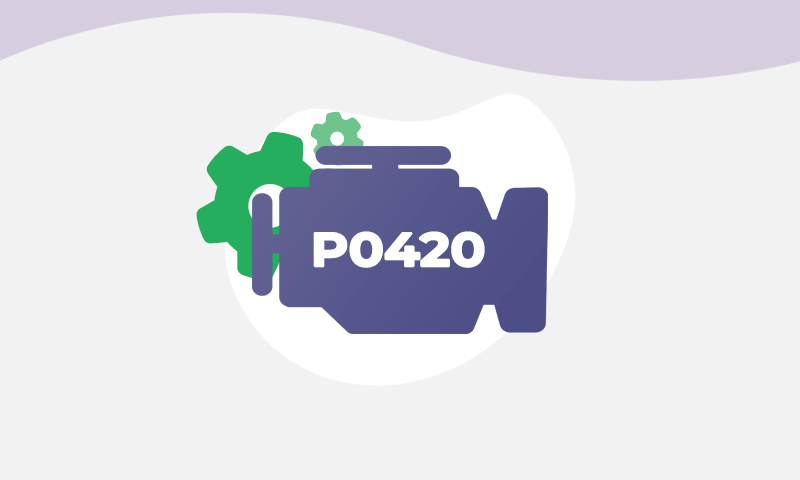
Advertiser Disclosure
Fix your check engine light yourself
The meaning of diagnostic trouble code (DTC) P0420: Catalyst System Efficiency Below Threshold (Bank 1) may sound complex. Still, it basically means that your car’s catalytic converter isn’t removing enough pollutants from the exhaust gases (its sole purpose). In particular, the engine control module (ECM) or powertrain control module (PCM) detected that the problem involved Bank 1 of the engine. A closely related code, P0430 , concerns the same issue: catalyst system efficiency is below the threshold but with Bank 2.
While a defective catalytic converter is usually at fault, knowing that other troubles can trigger a P0420 code is worthwhile. It’s critical to rule out other causes because catalytic converters are expensive to replace. Codes P0171 , P0172 , P0174 , and P0175 point to a problem with the oxygen sensor , mass air flow (MAF) sensor , and other trouble spots, which can impact the catalytic converter.
Further, an engine misfire (codes P0300 , P0301 , P0302 , P0303 , P0304 , P0305 , P0306 , P0307 , and P0308 ) could cause catalytic converter failure due to an imbalanced air-to-fuel ratio. Too much fuel (or too little oxygen) can damage the converter’s sensitive internal workings and generate a code P0420.
It’s wise to look for additional DTCs beyond P0420 so you won’t face the same problem later.
If there’s any good news about code P0420, you can still drive with this DTC in most cases. This isn’t permission to ignore the situation; the problem should be addressed in the next week or two. Continuing to drive with a P0420 can lead to engine and exhaust system damage and a loss of performance.
Keep reading to learn about code P0420, including causes, symptoms, repairs, and the most trouble-prone cars.

Possible Causes of P0420 & Their Repair Costs
Beyond a bad “cat,” a P0420 code can be triggered for many reasons. You’ll want to get to the root of the problem to ensure emissions compliance, restore proper engine operations, and minimize damage risk.
Check out the FIXD article on the most common causes of check engine lights .
Here’s an overview of the parts and systems that can cause a P0420 code and their average repair costs. Actual prices can depend on the vehicle and location.
Let’s explore how these failed components can cause a P0042 code.
Makes Commonly Affected By P0420
FIXD sensor data disclose that code P0420 is a common issue, regardless of manufacturer. Toyota fans will be surprised to learn that the venerable Camry is the most likely vehicle to incur a P0420-related error. Following close behind is the Corolla , with the Prius taking the third spot. Not only do these three Toyotas lead the pack, but they do so at a high occurrence level.
Other popular vehicles have a strong presence on this unfortunate roster. The stalwart F-150 is the most susceptible Ford for P0420 codes. Meanwhile, the midsize Edge crossover and compact Focus complete the trio.
Like Ford, Chevy’s most popular vehicle, the Silverado 1500 , has the greatest number of reported P0420 codes. The Equinox and Traverse crossovers aren’t too far behind.
P0420 codes are familiar territory for several Nissans, including the Altima , Sentra , and Frontier . Another Japanese brand, Subaru, rounds out fifth place. Three of the company’s core vehicles, the Outback , Impreza , and Forester , occupy the podium, not in a good way.
Interestingly, every vehicle mentioned here has a high occurrence rating for P0420 codes. This is unlike some other code observations, which had “most likely” cars with medium and low incidence rates. In other words, P0420-related error codes are frequent and far-reaching.
How to Diagnose the Cause of Your P0420 Code
Diagnosing a check engine light starts with using an OBD-II scanner to identify what’s causing the issue. The FIXD plug-in sensor will show the code and likely causes on your phone via the accompanying FIXD app . You can also try a basic code reader with a cable to plug into the car’s OBD-II port. In truth, there are only a few things a novice DIYer can do to identify what triggered a P0420 code. You’ll want a flashlight, gloves, safety goggles, and a rag to get star ted. A more involved effort will require essential hand tools.
Safety Essentials
Before exploring the source of a P0420 code, you’ll want to observe the following:
- Park on a level surface in a safe area
- Ensure the car is off and the parking brake is engaged
- Allow the engine to cool
Symptoms of P0420 Causes
While it’s reasonable to assume that a P0420 code just means replacing the catalytic converter, this isn’t the best approach. A catalytic converter is expensive to replace, so ruling out other problems can potentially save you money. Equally as vital, as mentioned earlier, is determining that there aren’t other trouble spots that have contributed to a faulty catalytic converter.

Click on each Possible Cause of a P0420 code to know the symptoms to look out for and what to inspect.
- Illuminated check engine light
- Rough idling
- Reduced fuel economy
- Engine stalling or hesitation
What to Inspect:
If accessible, remove each spark plug and look for oil or carbon deposits. The electrode may also be damaged or eroded.
If accessible, remove each spark plug wire individually and check for cracked insulation or a damaged connector.
An intermediate DIYer can conduct a 12-volt light tester for a more thorough effort.
- Engine hesitation
- Unusual engine noise
- Burning smell or unusual odor
- Gas pedal vibration
Check for cracks or damage to the exhaust components. Look for an accumulation of black soot along any suspected trouble areas. Pay attention to any exhaust fumes or gasoline odor in the engine bay or the passenger compartment (fumes in the cabin are serious due to the potential for carbon monoxide poisoning). Consult a technician trained to work with exhaust systems if a problem is suspected.
- Black exhaust smoke
- Failed emissions test
An intermediate DIYer or a technician can use a voltmeter to test the status of an oxygen sensor.
A bad wire or connector can falsely cause the oxygen sensor to generate inaccurate readings. Visually inspect the wiring and connector ends for signs of damage or deterioration.
- Rattling noise
- Sulfur smell
Due to precise emissions requirements, it’s best to consult a professional mechanic for catalytic converter issues.
In rare instances, the problem may be traced to reduced exhaust flow due to damage or blockage. This should be investigated before replacing a catalytic converter.
Can I drive with a P0420 code?
Quick answer: yes, it’s okay to drive with a p0420 code. for repairs, think days or weeks, not months. .
Because a P0420 code doesn’t always involve replacing the catalytic converter, you’ll want to deal with the problem sooner rather than later. Prompt action can mean catching the trouble when it’s easier to fix (meaning cheaper).
Critically, you should stop driving if the symptoms include hesitation, stalling, or performance loss. Such conditions can create a driving hazard, especially on a highway or when accelerating at an intersection turn. This usually isn’t the first symptom with code P0420, but it can happen when the blockage has gotten so bad that back pressure builds. Subpar engine performance can also be a sign that other troubles are involved.
Here’s a more detailed look at driveability with a P0420 code.
DIY | How To Fix P0420 Causes
If you live in a state with mandatory emissions testing, a P0420 code is a big deal. A faulty catalytic converter or a contributing problem can result in a failed emission test and a roadblock to vehicle registration. As a result, correcting these issues can require the services of a professional technician well-versed in emissions.
An advanced DIYer may know how to install a new catalytic converter (it’s not that hard), but a missing step or two can lead to a hassle with the DMV. So, do-it-yourself action around a P0420 code involves more essential measures. Yet, there’s one fundamental DIY rule to follow: only do what you’re comfortable doing and capable of completing. If you’re not confident taking a crack at things solo, move on to a trained mechanic. It’s the best way to avoid injury risk or damage to the car.
Possible Cause: Defective Spark Plug
What is it.
Spark plugs are essential to every gasoline engine. A fouled or defective plug is a common cause of engine misfires.
How hard is it to fix?
Difficulty level: easy/moderate.
Fortunately, replacing a spark plug is easy if you can get to it. Some transverse-mounted engines (mounted perpendicular to the length of the car) have spark plugs located near the firewall, making access challenging. You’ll need a few tools and supplies: replacement spark plugs (it’s best to replace them all), a gap gauge, a torque wrench (to avoid overtightening), a spark plug socket, a ratchet handle, and anti-seize for the spark plug threads. A spark plug boot puller can make disconnecting the spark plug wires easier, and spark plug boot grease will make the task easier in the future.
Cost of Repairs
On average, a new set of spark plugs costs $83– $112. Tools and supplies are separate.
Possible Cause: Damaged Spark Plug Wire
Like many things under the hood, a spark plug wire can degrade over time, affecting how the spark plug functions and leading to an engine misfire.
Replacing the spark wires is typically straightforward. Like with spark plugs, the greatest challenge is getting access to the connection points. You’ll also want to pay attention to the placement and length of each wire. A spark plug boot puller (see above) can help with the task, along with spark plug boot grease. Wire loom spacers can ensure the new wires are correctly positioned to prevent arcing-to-ground and cross-firing, which can damage other components.
Keep in mind that if one spark plug wire is bad, others will likely follow the same path. So, you might as well replace them all while you’re already busy in the engine bay.
On average, a new set of spark plugs costs $66– $84. Tools and supplies are separate.
Other DIY Considerations for Code P0420
Swapping out a bad oxygen sensor isn’t overly complicated, but access can be tricky, requiring persistence and moderate skill levels. The same applies to replacing an oxygen sensor connector or wiring harness. If tackling car repairs is a new experience, you might want to leave these activities to more experienced hands.
Before dealing with any code P0420-related repair, check whether your car is under warranty. You can save money by letting the automaker handle the work. In addition, research if there are any technical service bulletins (TSBs) for your car. TSBs are official repair/correction notices issued by the manufacturer that cover specific problem areas. You can research this online or contact a dealer.
P0420 Code FAQs
What makes and models does code p0420 affect the most.
Here’s a breakdown (in alphabetical order) of the vehicles most affected by code P0420, according to FIXD sensor data collected in 2023.
What causes code P0420?
Code P0420 is typically caused by a failing catalytic converter that can no longer efficiently clean exhaust emissions. Other potential causes include exhaust leaks, faulty oxygen sensors, or engine performance issues that lead to improper fuel mixture and incomplete combustion.
How can I prevent P0420 from occurring?
While there’s no way to completely prevent a P0420 code from happening, preventative measures can help reduce the risk. Maintain your vehicle regularly by changing oil, air filters, and spark plugs as recommended, and use high-quality fuel. Additionally, address any engine performance issues promptly and avoid short trips that don’t allow your catalytic converter to reach optimal operating temperature.
How long can you drive with a P0420 code?
Assuming there’s no stalling, hesitation, or loss of power (which can create a safety hazard), it’s acceptable to drive for a week or two with a code P0420. Continuing driving with this condition risks engine damage, increased emissions, and failed emissions testing.
What is the correct code designation, P0420 or PO420?
P0420 and PO0420 may look the same, but P0420 (the second character is a ‘zero’, not an ‘o’) is the correct usage. Most DTCs consist of a five-digit alphanumeric code that starts with a letter and is followed by four numbers.
References:
Repair-cost estimates, repairpal.com (various dates). Retrieved July 30, 2024, from repairpal.com .

Dave Goldberg is an automotive journalist and lifelong car fanatic. He writes for numerous enthusiast and business outlets and is an ongoing contributor to HotCars.com, one of the most popular car culture websites. When he’s not writing or driving, Dave is either under a hood or asleep. His credentials include a BA in Journalism from The George Washington University.
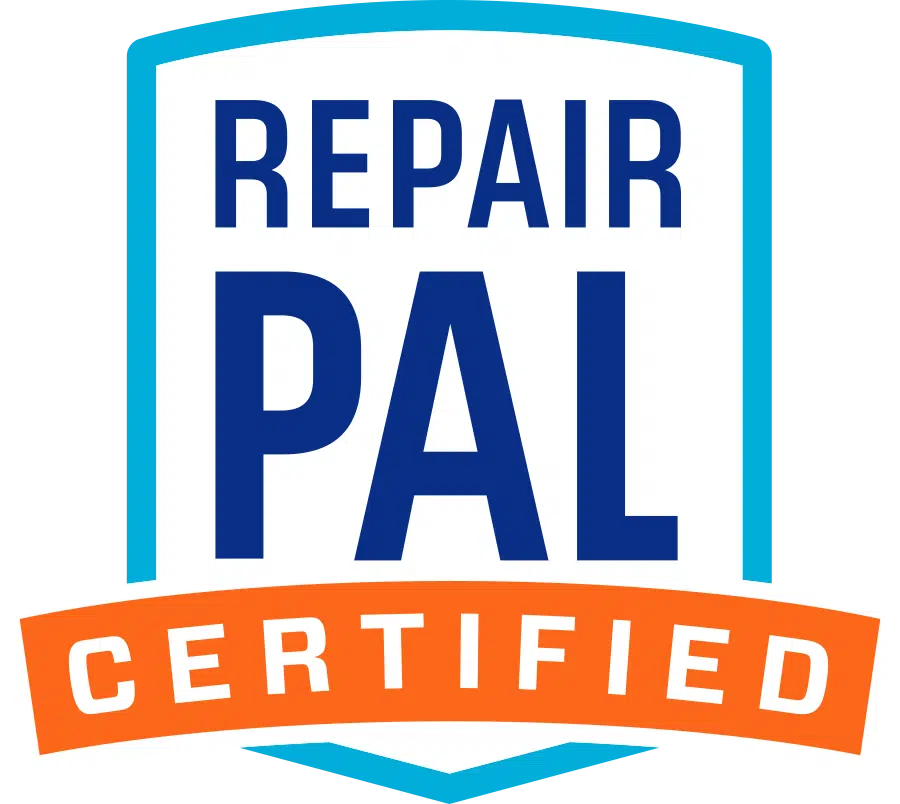
Find a Certified Shop
We've partnered with RepairPal to recommend trustworthy shops in your area. Enter your details to see certified shops near you that offer upfront estimates, guaranteed fair pricing, and a minimum 12-month, 12,000-mile warranty.
We’re here to help you simplify car care and save, so this post may contain affiliate links to help you do just that. If you click on a link and take action, we may earn a commission. However, the analysis and opinions expressed are our own.
- Check Engine Light , P0420
About the Author
You might also like

Top Makes and Models with DTC P0174
P0174 engine code | system too lean (bank 2), p0455 engine code | evaporative emission control system—large leak detected, explore car resources.
Car Insurance
Find the best insurance deals for your car
Everything you need to know about buying a vehicle

Car repair costs, how-to guides, and more
Vehicle Search
Search any make/model for reviews, parts and more

Fix P0420 yourself with FIXD!

Top Makes and Models with DTC P0455

Top Makes and Models with DTC P0420

P0135 Engine Code | Oxygen O2 Sensor Heater Circuit Malfunction (Bank 1, Sensor 1)
- Reviews of popular used cars
- Buying a Used Car: 10 Common Mistakes to Avoid
- How to get the best deal on a used car?
- How to inspect a used car
- How to check the engine when buying a used car
- What mileage is OK for a used car?
- Signs of automatic transmission problems
- Car Maintenance Checklist with Photos
- Car won't start: 3 common causes. Steps to diagnose
- Why Check Engine light is on?
- How car parts and sensors work
- Toyota Corolla 2009-2013
- Chevrolet Cruze 2011-2015
- Mazda 3 2010-2013
- BMW 3-series 2006-2011
- Toyota Camry 2012-2017
- Mazda 6 2014-2019
- Honda Accord 2008-2012
- Nissan Altima 2007-2012
- Subaru Outback 2010-2014
- Honda CR-V 2007-2011
- Honda Pilot 2009-2015
- Toyota RAV4 2006-2012
- Ford Escape 2013-2019
- Chevrolet Equinox 2010-2017
- Nissan Rogue 2014-2020
- Volkswagen Tiguan 2009-2017
- Toyota Venza 2009-2015
- Jeep Cherokee 2014-2020
- Dodge Journey 2009-2019
- Nissan Pathfinder 2013-2019
Code P0420 Catalyst Efficiency Below Threshold (Bank 1)
Can you keep driving with p0420 code, how the codes p0420, p0421 or p0430 are diagnosed:.
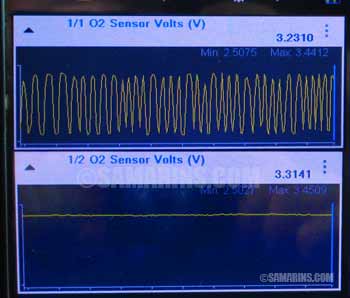
Causes of the codes P0420, P0421, P0431 and P0430
- Failed catalytic converter
- The catalytic converter could be contaminated, e.g., due to high sulfur content in the fuel.
- Exhaust leak.
- Aging front air/fuel ratio (front O2) sensor, especially if the rear sensor is new.
- Incorrect PCM software that needs to be updated
What can cause a catalytic converter to fail sooner?
Basic knowledge: how is the code p0420/p0430 set.
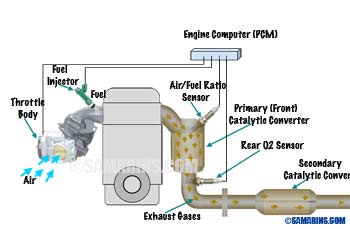
Related Articles:
Catalytic Converter: how it works, symptoms, problems, testing

- Forum Listing
- Marketplace
- Advanced Search
- The Minivan Mopar Garage
- 5th Generation Chrysler Minivans: 2008-2020
P0420 code on 2014 DGC 149k
- Add to quote
I was able to get Oxygen sensor data off my OBD app. Included in link. https://imgur.com/a/OtRAdCE -Alex
Drove around some more and dope-slapped myself- its the UPSTREAM Bank 1 sensor thats giving weird readings. so the cat is probably OK, and I need a new upstream O2 sensor in Bank 1. Got under the hood and that thing is super far under the dash. Any tips?
You are right, bank1s1 looks very lazy. I looked it up and It looks like you get at it from underneath, torque the new one to 32 ft/lbs, and never put dielectric grease on an o2 connector since they need to vent oxygen through them for proper operation. What app are you using? Just curious because I have a few Chrysler 3.6 datalogs posted on pidfusion.net, taken with mobile apps (disclaimer, its my site and a work in progress), anyways goodluck with the repair, you got this.
Alex Khalap said: Thanks for the advice - bought a torque wrench and ordered an o2 sensor. Seems they are the same part upstream and downstream. I was already planning to do 150k maintenance end of this week (Mobile1+filter, dump and flush the coolant, rotate tires, EBC OEM replacement discs and rotors all around), so will include the O2 sensor in the rest. Cool site! Its a great idea - how do you know what bad looks like if you dont know what good looks like. I was lucky enough to have a motor with two cats, so I could use one as control, but if I only had one cat, the diagnostic would be very hard for a noob. I hope your effort succeeds. Will post the (hopefully) "normal" graph after the new sensor is in - feel free to use it. I use a bluetooth OBD reader (forget the manufacturer) - it stays plugged in. The app is OBD Fusion for iOS - it has a list of compatible bluetooth readers, most are inexpensive. It also turns the iPad into an excellent auxiliary instrument cluster Had a question about the cooolant flush - on my old (1997)car I would dump the coolant, fill it with distilled water, run the motor for a while to let it circulate, dump the water and fill with new coolant. Is this also the preferred procedure for the 3.6? Click to expand...
Use only high purity water such as distilled or deionized water when mixing the water/engine coolant (antifreeze) solution. The use of lower quality water will reduce the amount of corrosion protection in the engine cooling system. Click to expand...
Alex, were you able to resolve your o2 sensor issue?
- ?
- 85.4K members
Top Contributors this Month

- Remember me Not recommended on shared computers
Forgot your password?
- Engine & Transmission
By ctennison November 11, 2020 in Engine & Transmission
- Reply to this topic
- Start new topic
Recommended Posts
So I got the P0420 code. I have a 2017 2.4L and its hard for me to believe the cat is bad. I've replaced both O2 sensors, new plugs, filter, cleaned the throttle body and almost every sensor in the car. Any ideas before I spend the money for a new cat?
Link to comment
Share on other sites.
What kind of driving do you do and what other CEL codes have you had in the recent past with the J? If a lot of short drives are done , put a good dose of Seafoam fuel system cleaner in the fuel tank and DRIVE highway speeds for the tank over the course of a week and see what it does. The 2.4 is not known to be that troublesome a motor. Also inspect the exhaust system for any cracks or openings between the upstream and downstream O2 sensors, They can throw some pretty weird codes if air can get in before the downstream sensor. And it is the downstream sensor that is the primary trigger for the P0420 code, Note these motors are also pretty finicky on OE brand sensors, Hope you used OE.
No other codes, not running bad, not doing anything other then the P0420 code. The O2 sensors are bosch. I can clear it and sometimes it will come right back on or it will be a few days. It always does it under 2,000 RPMs and about 50 MPH.
I've had mopars for over 25 years and never had good luck with BOSCH brand O2 sensors. I'd suggest try replacing the downstream one with an OE brand like NTK(or NKT...I'm partly dyslexic ,,,LOL;) )
Run some Seafoam in the fuel, it will also help clean out the converter.
- jkeaton and agm2112

I'll give it a shot, thank you.
Join the conversation
You can post now and register later. If you have an account, sign in now to post with your account. Note: Your post will require moderator approval before it will be visible.

× Pasted as rich text. Paste as plain text instead
Only 75 emoji are allowed.
× Your link has been automatically embedded. Display as a link instead
× Your previous content has been restored. Clear editor
× You cannot paste images directly. Upload or insert images from URL.
- Insert image from URL
- Submit Reply
- Existing user? Sign In
More Forum Apps
- Online Users
- Leaderboard
|| Forum Activity ||
- All Activity
- Create New...

- Visit Our Blog about Russia to know more about Russian sights, history
- Check out our Russian cities and regions guides
- Follow us on Twitter and Facebook to better understand Russia
- Info about getting Russian visa , the main airports , how to rent an apartment
- Our Expert answers your questions about Russia, some tips about sending flowers

Russian regions
- Chelyabinsk oblast
- Khanty-Mansi okrug
- Kurgan oblast
- Sverdlovsk oblast
- Nizhny Tagil
- Tyumen oblast
- Yamalo-Nenets okrug
- Map of Russia
- All cities and regions
- Blog about Russia
- News from Russia
- How to get a visa
- Flights to Russia
- Russian hotels
- Renting apartments
- Russian currency
- FIFA World Cup 2018
- Submit an article
- Flowers to Russia
- Ask our Expert
Sverdlovsk Oblast, Russia
The capital city of Sverdlovsk oblast: Ekaterinburg .
Sverdlovsk Oblast - Overview
Sverdlovsk Oblast is a federal subject of Russia, the largest region of the Urals, located on the border between Europe and Asia in the Urals Federal District. Yekaterinburg is the capital city of the region.
The population of Sverdlovsk Oblast is about 4,264,300 (2022), the area - 194,307 sq. km.
Sverdlovsk oblast flag
Sverdlovsk oblast coat of arms.
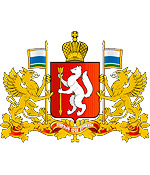
Sverdlovsk oblast map, Russia
Sverdlovsk oblast latest news and posts from our blog:.
26 May, 2020 / Unique Color Photos of Yekaterinburg in 1909 .
2 December, 2018 / Yekaterinburg - the view from above .
21 November, 2018 / Abandoned Railway Tunnel in Didino .
12 October, 2017 / Northern Urals: Manpupuner Plateau and Dyatlov Pass .
20 April, 2015 / Multicolored aurora borealis in the Northern Urals .
More posts..
History of Sverdlovsk Oblast
The first people settled here in the Stone Age. At the end of the 16th century, the Russian kingdom gained control of the region. In the 17th century, the most significant stage of the initial development of this area happened, when Russian settlers began a massive advance to the east. In 1598, the first settlers founded the town of Verkhoturye on the territory of the present Sverdlovsk region.
Verkhoturye became the first capital of the Urals because of its strategic location on the Babinov road - an important crossroads of trade routes. Sverdlovsk oblast acted as a transshipment base between the central part of the country and the actively developed regions of Siberia and Central Asia.
The presence of strategic reserves of iron and copper ore, as well as large forest areas, predetermined the specialization of the region (ferrous and non-ferrous metallurgy, wood processing, mining, etc.). Exploration of minerals in the Sverdlovsk region began at the end of the 17th century.
In the 18th century, the Demidov dynasty founded several plants in the region that turned into large production and economic complexes. The local industry was characterized by a high level of technological development. The blast furnaces of the Ekaterinburg, Nevyansk, Tagil iron-making plants were superior in performance to the best European models of that time, and their products were the leading item of Russian exports.
More historical facts…
The launch of the Trans-Siberian Railway became a landmark event in the life of the Middle Urals, allowing large-scale export of plant products. Between 1920 and 1930, the Urals was able to once again take its place as the leading industrial region of Russia by strengthening its mining industry, creating new production facilities, developing energy and mass urban construction.
In the years of the first five-year plans, along with the reconstruction of old enterprises, several new large industrial facilities were opened: Uralmashzavod, Uralelektrotyazhmash, tool and ball bearing plants in Sverdlovsk, Uralvagonzavod and Nizhny Tagil metallurgical plant in Nizhny Tagil, pipe plants in Pervouralsk and Kamensk-Uralsky, copper smelters in Krasnouralsk and Sredneuralsk, the Ural aluminum smelter in Kamensk-Uralsky and others.
On October 3, 1938, the territory of Sverdlovsk Oblast was finally formed. During the Second World War, from July 1941 to December 1942, more than 2 million people came to the Urals region, of which more than 700 thousand stayed in Sverdlovsk Oblast.
In the postwar period, Sverdlovsk Oblast continued to develop as a major industrial center of the Urals. The industry of the region was a supplier of the most important types of machinery, products of ferrous and non-ferrous metallurgy, chemical, electric power, light, and food industries. Mechanical engineering and metalworking retained their leading place in the structure of the local industry.
Being one of the most important industrial and defense centers of the Soviet Union, the Sverdlovsk region remained closed to foreigners until 1991.
Beautiful nature of Sverdlovsk Oblast
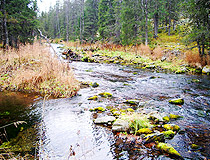
Forest stream in Sverdlovsk Oblast
Author: Vlasov Pavel
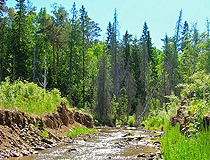
Sverdlovsk Oblast nature
Author: Oleg Seliverstov

Sverdlovsk Oblast is rich in forests
Sverdlovsk Oblast - Features
Sverdlovsk Oblast received its name from its administrative center - the city of Sverdlovsk (Yekaterinburg). The name appeared on January 17, 1934, together with the formation of the region. After renaming Sverdlovsk back to Yekaterinburg, the region was not renamed and retained its Soviet name.
The territory of Sverdlovsk Oblast stretches from west to east for 560 kilometers, from north to south - for 660 kilometers. The climate is continental. The average temperature in January is about minus 16-20 degrees Celsius, in July - plus 19-30 degrees Celsius.
The Sverdlovsk region, being one of the oldest mining regions of Russia, is rich in a variety of natural resources. Today, the local mineral and raw materials base provides a significant part of the production of Russian vanadium, bauxite, chrysotile-asbestos, iron ore, refractory clay. The region is the main raw source for Russian aluminum industry.
There are significant reserves of nickel ores, precious metals, mineral and fresh groundwater, practically unlimited reserves of building materials. There are deposits of stone and brown coals, chromites, manganese and certain prospects for discovering oil and gas fields. Forests cover about 80% of the territory.
Sverdlovsk Oblast is an important transport hub of Russia. The Trans-Siberian Railway passes through its territory. Koltsovo is a large international airport located in Yekaterinburg. The largest cities and towns of Sverdlovsk Oblast are Yekaterinburg (1,493,600), Nizhny Tagil (340,700), Kamensk-Uralsky (162,500), Pervouralsk (117,700), Serov (93,900), Novouralsk (79,000), and Verkhnyaya Pyshma (76,400).
Sverdlovsk Oblast is known for its traditional International exhibition of armament in Nizhny Tagil, annual Russian Economic Forum in Yekaterinburg. Yekaterinburg is the 4th largest scientific center in Russia after Moscow, Saint-Petersburg and Novosibirsk.
It is one of the most important industrial regions of Russia. The structure of the local industrial complex is dominated by ferrous and non-ferrous metallurgy, enrichment of uranium and iron ore, engineering.
The largest enterprises of ferrous and nonferrous metallurgy are the Nizhnetagilsky Metallurgical Combine, the Kachkanar GOK Vanadiy, VSMPO-Avisma, the Pervouralsky Novotrubny Plant, the Bogoslovsky and the Ural Aluminum Smelters, the Kamensk-Uralsk Metallurgical Plant, the Sinarsky Pipe Plant, the Seversk Pipe Plant, as well as enterprises of the Ural Mining and Metallurgical Company (Uralelectromed, Sredneuralsky Copper Smelting Plant, Metallurgical Plant named after A.K. Serov, etc.).
The most important enterprises of the machine-building complex are Uralvagonzavod, Ural Heavy Machinery Plant, Uralelectrotyazhmash, Uralkhimmash, Ural Turbine Plant, Ural Civil Aviation Plant. Uralkhimplast, which produces synthetic resins, is the largest chemical plant in Russia.
Attractions of Sverdlovsk Oblast
Coniferous forests and numerous rivers make the nature of the Sverdlovsk region attractive for tourists. There is a number of reserves and nature parks: Visimsky State Nature Reserve, Denezhkin Kamen National Nature Reserve, Pripyshminsky Bory National Park, Oleny Ruchi Nature Park, Chusovaya River Nature Park, Bazhovskiye Places Nature Park, Rezhevskoy Nature and Mineralogical Reserve.
Some of the most interesting sights located outside of Yekaterinburg:
- Nevyansk Tower - a leaning tower in the center of the town of Nevyansk, built by the order of Akinfiy Demidov, the founder of the mining industry in the Urals, in the first half of the 18th century;
- Cathedral of the Savior’s Transfiguration in Nevyansk;
- Battle glory of the Urals - an open-air museum of military equipment in Verkhnyaya Pyshma;
- Automotive equipment museum in Verkhnyaya Pyshma - one of the largest collections of Russian cars, special equipment, motorcycles, bicycles;
- Obelisk symbolizing the border between Europe and Asia in Pervouralsk;
- Verkhoturye - a historical town with a kremlin and a lot of churches called the spiritual center of the Urals. The Cross Exaltation Cathedral of the St. Nicholas Monastery is the third largest cathedral in Russia after the Cathedral of Christ the Savior in Moscow and St. Isaac’s Cathedral in St. Petersburg;
- Mount Kachkanar located near the border between Europe and Asia. At the top of the mountain there is the Buddhist Monastery of Shad Tchup Ling;
- Monastery in the name of the Holy Royal Passion-Bearers on Ganina Yama standing on the site of the extermination and the first burial of the remains of the family of the last Russian Emperor Nicholas II and his servants;
- Museum Complex Severskaya Domna in Polevskoy, 52 kilometers from Ekaterinburg - an industrial and architectural monument (1860);
- Open-air museum in Nizhnyaya Sinyachikha - Ural wooden architecture and the richest collection of the Ural house painting;
- Severskaya Pisanitsa - a monument with rock paintings and images of the Neolithic Age located near the village of Severka.
Sverdlovsk oblast of Russia photos
Pictures of the sverdlovsk region.

Sverdlovsk Oblast scenery
Author: Anatoliy Kislov
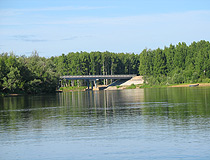
Bridge in Sverdlovsk Oblast
Author: Igor Romanov
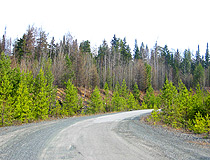
Road in the Sverdlovsk region
Sverdlovsk Oblast views

Field of dandelions in Sverdlovsk Oblast
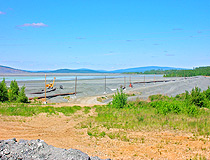
Winter in Sverdlovsk Oblast
Author: Isupov Sergei
Churches in Sverdlovsk Oblast
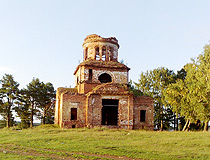
Abandoned church in the Sverdlovsk region
Author: Timofey Zakharov

Wooden church in Sverdlovsk Oblast

Orthodox church in Sverdlovsk Oblast
Author: Kutenyov Vladimir
The comments of our visitors
- Currently 2.93/5
Rating: 2.9 /5 (181 votes cast)
Your location
Profile Login
Weather in Yekaterinburg, Sverdlovsk, Russia
Current conditions in yekaterinburg, today's forecast, tomorrow's forecast, current time in yekaterinburg, sverdlovsk, russia.
Click here for the Current Time in Yekaterinburg, Sverdlovsk, Russia
Like this location? Make it a Weather Favorite!
Add Yekaterinburg, Sverdlovsk, Russia to my favorites!
Bookmark this location to check the time and temperature with forecast and current weather conditions in Yekaterinburg, Sverdlovsk, Russia before making travel plans for a hotel or flight to Yekaterinburg, Sverdlovsk, Russia Whether is it rainy or sunny, chilly or warm, you'll know before you pick up your phone.
In addition to Yekaterinburg, Sverdlovsk, Russia, we have a list of more cities around the world available, which you can view weather by country name or create a list of your favorite locations where you have business or personal interests.
The word "weather" in English can be translated as wetter in German, temps in French, tiempo in Spanish, and il tempo in Italian.
Select A Location
Subscribe to our newsletter, recent articles.
- The Pros and Cons of Permanent Daylight Saving Time
- Senate Approves Permanent Daylight Saving Time Bill
- Why January Mornings are Darker
- Why Eastern Time is the Most Commonly Used Time Zone
- Does Brazil Have Four Time Zones?
- What Ontario Needs to Receive More Daylight in the Holiday Season
- Oklahoma State University Extension Teaches How to Overcome Winter Blues
- New Bill in the State Needs Federal Approval
- Washington Gets Stuck in the Draconian Tradition as It Observes Daylight Saving Time
- Expect Shorter Days and Colder Weather This December 2021
Add Clock To Your Website

IMAGES
VIDEO
COMMENTS
Here's a good P0420 diagnostic order for the Dodge Journey: 1. Check for Other Codes. The first thing you want to do when trying to fix P0420 in the Journey is to verify there aren't any other trouble codes. Three types of codes can give clues as to what's going on with your vehicle. Misfire Codes.
How to fix a Dodge with a P0420 Code, "Catalyst System Efficiency Below Threshold (Bank 1)."Cataclean 120007 on Amazon: https://amzn.to/3EkiF4nRead here for ...
P0420 is a diagnostic trouble code that relates to the catalytic converter on bank 1 in Dodge vehicles. When this code appears, it suggests that there is a malfunction with the catalytic converter, specifically on bank 1. The catalytic converter is responsible for reducing harmful emissions from the vehicle's exhaust system.
On 5/2/2023 at 4:12 PM, Jmoreyra said: I have a 2014 dodge journey 3.6l SXT AWD showing code P0420. I swapped both upstream and down stream with Bosch O2 sensors and it spit out more codes. Thanks to the forum, I found out that the NTK O2 sensors were best so I swapped the Bosch ones out and replaced with the NTK's. It went back to the P0420 code.
Specific to Chrysler products, these are the more common issues with the Catalyst System Efficiency Below Threshold (Bank 1) fault code: Dodge Avengers w/2.4L - Failed catalytic converters and oxygen sensors are the most common issue related to P0420. Dodge Avengers w/3.6L - Failed catalytic converters and oxygen sensors are the most common ...
Journey's Year:2015. Posted April 25, 2018. For clarity sake - I meant one upstream and one downstream O2 sensor, not two of each. The upstream sensor is at the front of the catalytic converter just behind the joint between it and the exhaust manifold. The downstream is in in the middle of the converter.
The P0420 engine code indicates the catalyst system efficiency is below the threshold (Bank 1). A P0420 code indicates a problem with the catalytic converter, more specifically. The purpose of the catalytic converter is to break down harmful pollutants created during the combustion cycle. By using fine platinum and gold meshes to filter exhaust ...
Code P0420 Dodge Description. The Engine Control Module (ECM) monitors the switching frequency ratio of heated oxygen sensors 1 (front O2 sensor) and heated oxygen sensors 2 (rear O2 sensor). A three way catalyst converter (Manifold) with high oxygen storage capacity will indicate a low switching frequency of heated oxygen sensor 2.
2014 Dodge Journey OBD2 Code P0420 Catalyst System Efficiency Below Threshold. What Does OBD-II Fault Code P0420 Mean? OBD-II Code P0420 is defined as a Catalyst System Efficiency Below Threshold P0420 Symptoms Check Engine Light will illuminate In most cases, there are no adverse conditions noticed by the driver
P0420 stands for "Catalyst System Efficiency Below Threshold (Bank 1).". This trouble code is triggered when the on-board computer detects that the bank 1 of the catalytic converter is underperforming. A faulty catalytic converter (usually due to overheating and contamination) is the most common reason why this code is logged.
The meaning of diagnostic trouble code (DTC) P0420: Catalyst System Efficiency Below Threshold (Bank 1) may sound complex. Still, it basically means that your car's catalytic converter isn't removing enough pollutants from the exhaust gases (its sole purpose). In particular, the engine control module (ECM) or powertrain control module (PCM) detected that the problem involved Bank 1 of the ...
October 08, 2022. The code P0420 - Catalyst Efficiency Below Threshold (Bank 1) means that there is a problem with the catalytic converter of the Bank 1. The code P0430 means the same fault for the Bank 2 catalytic converter in an engine with two cylinder banks (e.g., V6 or V8). The catalytic converter or "cat" is a key component of the vehicle ...
This article will therefore deal with code P0420 as it applies specifically to Chrysler vehicles. OBD II fault code P0420 is a generic trouble code that is defined as "Catalytic converter system, bank 1 - efficiency below threshold" and is set when the PCM (Powertrain Control Module) detects a condition in which the efficiency of the ...
On my 2012 journey, MIL just came on, run OBD-II scan tool and what I get:""""" 2/21/2015 12:45:52 Dodge Journey 2012 Error#P0420 Catalyst System Efficiency Below Threshold (Bank 1) Freeze Frame for DTC P0420 Fuel System Status Bank One Closed Loop Fuel System Status Bank Two Closed Loop Calculat...
Alex Khalap Discussion starter. 5 posts · Joined 2018. #1 · Sep 10, 2018. Just ran into the same P0420 code that folks have been posting about on my 2014 Grand Caravan with 149k. I scanned the other threads and didnt see any resolutions so here goes: If you guys answer my plea for help, I will do my forum duty to post the resolution in detail.
Tech Notes. As the code description implies the P0420 code means that the vehicle's control module has detected that the three-way catalytic converter is not working properly (is not as efficient as the factory is expecting). Replacing the oxygen (O2) sensors may sometimes fix the code, but in most cases, the catalytic convert needs to be ...
3. Region:Decline. Journey's Year: 2017. Posted November 11, 2020. So I got the P0420 code. I have a 2017 2.4L and its hard for me to believe the cat is bad. I've replaced both O2 sensors, new plugs, filter, cleaned the throttle body and almost every sensor in the car.
Yekaterinburg is the capital of Sverdlovsk Oblast of Russia. A city of over 1.3 million inhabitants, it is a center of industry and culture in the broader Urals region, and the 4th largest city in the country after Moscow, Saint Petersburg and Novosibirsk. Photo: Vyacheslav Bukharov, CC BY-SA 4.0. Photo: A.Savin, FAL.
14. Visit the Old Water Tower. Source: Photo by Wikimedia Commons user Dom kobb used under CC BY-SA 3.0. The old water tower is one of Yekaterinburg's oldest structures dating back to the 1800s and stands as a monument of industrial architecture. It is one of the city's endearing symbols.
Sverdlovsk Oblast is a federal subject of Russia, the largest region of the Urals, located on the border between Europe and Asia in the Urals Federal District. Yekaterinburg is the capital city of the region. The population of Sverdlovsk Oblast is about 4,264,300 (2022), the area - 194,307 sq. km.
Passing showers. Breaks of sun late. Pleasantly warm. Hi: 81°F / 27°C Current Time in Yekaterinburg, Sverdlovsk, Russia